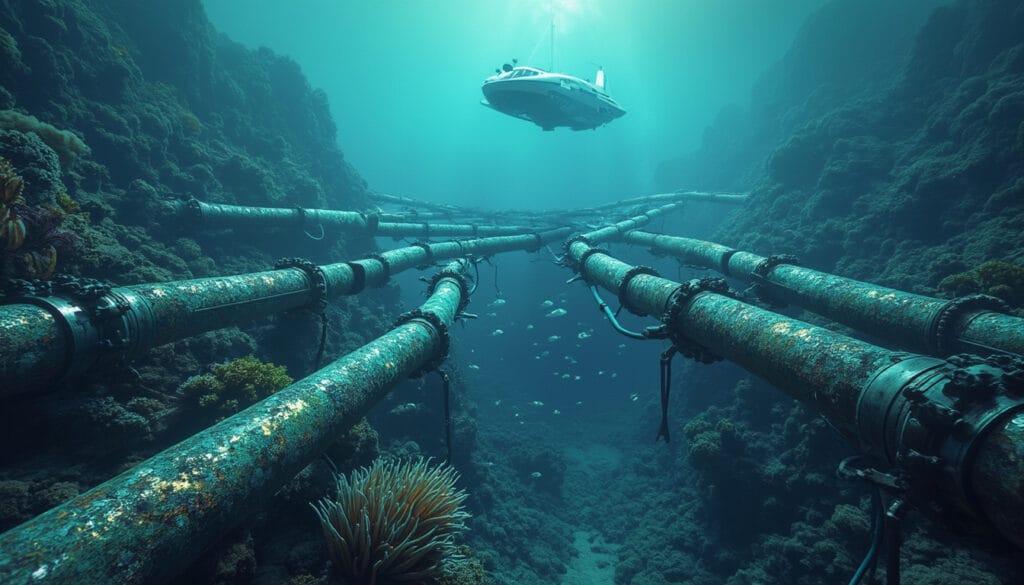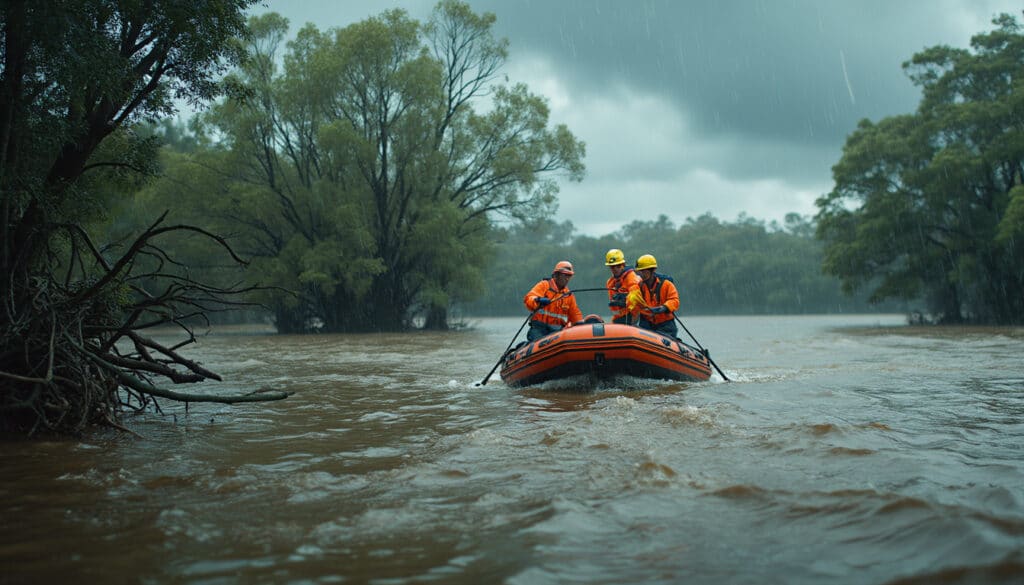“`html
Offshore energy infrastructures are essential to Europe’s electricity supply.
These complex networks, composed of pipelines, platforms, and underwater cables, are the result of advanced engineering and seamless international cooperation.
However, the threats to these critical structures are increasing.
Recent incidents, such as the sabotage of the Nord Stream pipeline, highlight the vulnerability of these vital systems. Intentional attacks or accidental failures can have disastrous consequences for economies and national security. In light of this reality, it becomes imperative to enhance the protection of offshore energy infrastructures. Traditional monitoring strategies are insufficient, requiring the integration of innovative technologies and international collaboration. Industry stakeholders must adopt a proactive approach to anticipate and counter emerging threats.

Why are underwater pipelines critical for European energy?
Underwater pipelines are the backbone of Europe’s energy supply. These complex networks, composed of pipelines, platforms, and underwater cables, are the result of unprecedented advanced engineering and international cooperation. In 2024, for example, the European Union imported 16.5 million metric tons of liquefied natural gas from Russia, transported through these pipelines. This energy dependence underscores the strategic importance of securing these infrastructures to ensure economic stability and national security.
Underwater pipelines not only transport energy resources; they also symbolize a political and economic interconnection between nations. Their role is even more crucial in the current context where the transition to renewable energy is gaining momentum. By ensuring a constant and reliable supply, these infrastructures support European ambitions regarding energy transition and sustainability.
Moreover, underwater pipelines are often located in sensitive geopolitical areas, increasing their vulnerability to international tensions. Securing these pipelines thus becomes a geopolitical imperative, requiring heightened vigilance and sophisticated protection strategies to prevent any form of disruption or attack.
What are the current risks to offshore energy infrastructures?
Offshore energy infrastructures face a multitude of growing risks. Among the most concerning threats are deliberate sabotage acts, such as the attack on the Nord Stream pipeline in 2022, which highlighted the vulnerability of these critical systems. Additionally, repeated failures of underwater cables in high-risk areas, such as the Baltic Sea and the vicinity of Taiwan, indicate a worrying trend of maritime incidents.
Another major risk comes from dark activities carried out by clandestine fleets, often associated with countries like Russia and China. These ships, known as the dark fleet, operate by concealing their identities and disabling signals from their Automatic Identification System (AIS). This opacity makes them nearly invisible to global tracking systems, thereby facilitating illegal activities such as the sabotage of underwater infrastructures.
The complexity of securing underwater infrastructures is also exacerbated by the logistical challenges and the international scope of these installations. Often located beyond territorial waters, in Exclusive Economic Zones (EEZ) or international waters, these infrastructures fall outside the jurisdiction of a single state, complicating efforts for protection and pursuing responsible parties in the event of an incident.
How do attacks on underwater pipelines impact geopolitics?
Attacks on underwater pipelines have profound repercussions on global geopolitics. By disrupting energy supply, these acts can weaken national economies and compromise the security of dependent nations. For instance, the attack on an offshore gas platform used by Russian forces in the Black Sea not only affected energy transit but also exacerbated tensions between Ukraine and Russia.
These attacks are often perceived as acts of war or economic terrorism, prompting countries to bolster their security measures and reassess their energy strategies. They can also influence international alliances and energy policies, pushing nations to diversify their energy sources and invest more in the security of critical infrastructures.
Furthermore, securing underwater pipelines becomes a central point of diplomatic negotiations and international agreements. States seek to establish common security protocols and share intelligence information to prevent future incidents. This cooperation is essential to maintain energy stability and prevent regional conflicts from escalating into global energy crises.
What are the evolving tactics of malicious actors?
The tactics used by malicious actors to target underwater pipelines are constantly evolving, making the protection of these infrastructures more complex. One recent method involved the Chinese vessel Shunxing 39, accused of cutting a submarine fiber optic cable near the shores of Taiwan. This ship used up to three false identities to conceal its involvement in the incident, demonstrating the ingenuity of malefactors to evade detection.
Specialized devices
Chinese engineers have also patented devices specifically designed to cut underwater cables. The 2020 patent describes a “towed underwater cable cutting device,” capable of quickly and efficiently severing cables using a sharp and heavy tool. The mere existence of such devices indicates an increased potential threat, with specialized tools enabling more sophisticated sabotage acts against critical infrastructures.
These tactics show an evolution towards more deliberate and technically advanced attacks, making the monitoring and protection of offshore energy infrastructures more challenging. Malicious actors exploit technological vulnerabilities and low-surveillance areas to carry out their operations, requiring adaptive and innovative responses from security agencies.
What challenges do we face in securing these infrastructures?
Securing underwater pipelines presents multiple challenges, both physical and logistical. One of the main obstacles is the vast extent of the infrastructures, often located in remote and hard-to-reach areas. This complicates the implementation of continuous and effective monitoring measures, making it difficult to quickly detect intrusions or damage.
Another major challenge lies in the international nature of the waters where these pipelines are located. Being generally situated beyond territorial waters, in Exclusive Economic Zones (EEZ) or international waters, these infrastructures are not under the jurisdiction of any specific country. This situation complicates law enforcement and the prosecution of malicious acts, as there is no clear responsibility or single authority to intervene.
Moreover, traditional security methods, such as AIS monitoring, are no longer sufficient by themselves. Malicious actors can easily disable or manipulate these systems, rendering installations vulnerable to undetected attacks. The diversity of private ownership of energy infrastructures also introduces fragmentation of responsibilities, complicating the coordination and implementation of coherent security strategies.
How to enhance the resilience of underwater pipelines?
Enhancing the resilience of underwater pipelines requires a multifaceted approach combining advanced technology, international cooperation, and substantial investments in security. Establishing proactive monitoring systems is essential to detect and respond to threats in real-time. This includes using artificial intelligence (AI) technologies to analyze surveillance data and identify suspicious behaviors before they escalate into major incidents.
Private companies can play a crucial role by investing in independent intelligence capabilities, such as proprietary maritime risk assessment tools and commercial satellite data. These investments improve early detection and rapid response to threats, thereby reducing the risks of prolonged disruptions of energy infrastructures.
Another key aspect of enhancing resilience is integrating a dual-layer approach that combines governmental and private intelligence. This synergy allows for better situation awareness and more effective incident response, thus increasing the overall robustness of security systems.
Why is international collaboration essential?
Given the cross-border nature of threats to underwater pipelines, international collaboration is indispensable to ensure effective protection of these vital infrastructures. The legal and sovereignty challenges associated with securing infrastructures located in international waters require close coordination among nations and international organizations.
Organizations such as NATO and the European Maritime Safety Agency (EMSA) play a central role in establishing standardized security protocols and facilitating the sharing of critical information among countries. This cooperation helps bridge legal gaps and enhance the collective capacity to respond rapidly to security incidents.
Furthermore, international cooperation promotes the exchange of technologies and best practices in security, thus strengthening nations’ capabilities to protect their energy infrastructures. It also encourages the development of joint strategies to counter the evolving tactics of malicious actors, ensuring a coordinated and effective defense against emerging threats.
The benefits of an integrated security approach
Adopting an integrated security approach is crucial to protecting underwater pipelines from current and future threats. This involves combining various strategies and technologies to create a coherent and robust defense. Integrating advanced monitoring systems, such as underwater sensors and maritime drones, allows for comprehensive coverage and early detection of anomalies.
The use of artificial intelligence (AI) to analyze collected data enhances the capacity for incident prediction and prevention. AI algorithms can identify unusual or suspicious patterns, thereby signaling potentially malicious activities well before they cause significant damage.
In parallel, training and capacity building of security teams are essential to ensure a rapid and effective response to incidents. Regular exercises and simulations allow for testing and improving response protocols, thus ensuring optimal preparedness against real threats.
Case study: The attack on the Nord Stream pipeline
The attack on the Nord Stream pipeline in 2022 serves as a striking example of the risks facing underwater energy infrastructures. This act of sabotage not only interrupted the flow of natural gas to Europe but also intensified geopolitical tensions between Russia and the European Union.
According to Ami Daniel, CEO of Windward, “Attacks like the one on Nord Stream perfectly illustrate the vulnerability of our energy infrastructures and the necessity of uniting our efforts to protect them effectively.” This incident highlighted the importance of proactive monitoring and international cooperation to prevent future saboteurs.
In response, enhanced security measures have been implemented, including increased surveillance of critical areas and close collaboration among affected nations. This attack has also spurred investments in advanced detection technologies and underscored the importance of increased resilience to ensure the continuity of energy supply in the face of growing threats.
Articles similaires
Thank you!
We will contact you soon.














